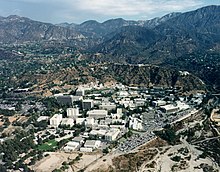JPL Science Division: Difference between revisions
tidy coord params in infobox |
Rescuing 2 sources and tagging 0 as dead. #IABot (v1.3beta8) |
||
| Line 30: | Line 30: | ||
| chief1_position = Division Manager<ref>{{cite web|title=JPL's Science Division: People|url=https://science.jpl.nasa.gov/people/Watkins/|website=JPL Science Division|publisher=NASA|accessdate=3 April 2015}}</ref> |
| chief1_position = Division Manager<ref>{{cite web|title=JPL's Science Division: People|url=https://science.jpl.nasa.gov/people/Watkins/|website=JPL Science Division|publisher=NASA|accessdate=3 April 2015}}</ref> |
||
| chief2_name = Dan McCleese |
| chief2_name = Dan McCleese |
||
| chief2_position = Chief Scientist<ref name=SciTech>{{cite web|title=Office of the Chief Scientist and Chief Technologist|url=http://scienceandtechnology.jpl.nasa.gov/ocsct/|website=JPL Science Division|publisher=NASA|accessdate=3 April 2015}}</ref> |
| chief2_position = Chief Scientist<ref name=SciTech>{{cite web|title=Office of the Chief Scientist and Chief Technologist |url=http://scienceandtechnology.jpl.nasa.gov/ocsct/ |website=JPL Science Division |publisher=NASA |accessdate=3 April 2015 |deadurl=yes |archiveurl=https://web.archive.org/web/20150402075342/http://scienceandtechnology.jpl.nasa.gov/ocsct/ |archivedate= 2 April 2015 |df= }}</ref> |
||
| chief3_name = Jonas Zmuidzinas |
| chief3_name = Jonas Zmuidzinas |
||
| chief3_position = Chief Technologist<ref name=SciTech/> |
| chief3_position = Chief Technologist<ref name=SciTech/> |
||
| Line 69: | Line 69: | ||
The division's science, technology and engineering research covers many areas of planetary, astrophysics and Earth science, both as basic research leading to new observations and mission concepts, as well as research based on the data acquired by JPL flight projects.<ref name=resch-areas/> Technology research covers areas ranging from robotic systems, a range of in-situ and [[remote sensing]] instruments, deep space communications and navigation, information systems, precision flying and planetary protection and survivability.<ref name=resch-areas> |
The division's science, technology and engineering research covers many areas of planetary, astrophysics and Earth science, both as basic research leading to new observations and mission concepts, as well as research based on the data acquired by JPL flight projects.<ref name=resch-areas/> Technology research covers areas ranging from robotic systems, a range of in-situ and [[remote sensing]] instruments, deep space communications and navigation, information systems, precision flying and planetary protection and survivability.<ref name=resch-areas> |
||
{{Cite web |
{{Cite web |
||
| |
|title=Research Topics List |
||
| |
|work= |
||
| |
|publisher=Jet Propulsion Laboratory |
||
| |
|date=September 2010 |
||
| |
|url=http://scienceandtechnology.jpl.nasa.gov/research/ResearchTopics/ |
||
| |
|format= |
||
| |
|accessdate=2010-09-14 |
||
|deadurl=yes |
|||
|archiveurl=https://web.archive.org/web/20100930180015/http://scienceandtechnology.jpl.nasa.gov/research/ResearchTopics/ |
|||
|archivedate=2010-09-30 |
|||
|df= |
|||
}}Public domain material from JPL and NASA</ref> |
|||
{{-}} |
{{-}} |
||
Revision as of 03:30, 22 April 2017
This article needs additional citations for verification. (June 2011) |
 | |
 | |
 Aerial view of the Jet Propulsion Laboratory in La Cañada Flintridge, California | |
| Agency overview | |
|---|---|
| Formed | 1936 |
| Type | Terrestrial and extraterrestrial sciences |
| Jurisdiction | United States |
| Headquarters | Pasadena, California 34°12′04″N 118°10′21″W / 34.201060°N 118.172453°W |
| Agency executives | |
| Parent department | Jet Propulsion Laboratory |
| Parent agency | NASA |
| Website | science science |
The Jet Propulsion Laboratory (JPL) Science Division investigates physical and chemical processes on the Earth, in the Solar System, and throughout the universe. Explorations of space and terrestrial processes lead to understanding of the universe. Methods for accomplishing scientific work pertaining to the nature of the Earth, the Solar System, the galaxy, etc., are addressed in the JPL Science Division. Techniques in both physical and life sciences are utilized.[3]
Coverage

Research areas include studying the nature of the Martian surface, the causes and mitigation of ozone depletion and global warming in Earth's atmosphere, the search for life in and the nature and evolution of the universe. These are significant issues related to NASA's mission.[3]
Theoretical and experimental studies are conducted which lead to new missions. They are engaged in the development of new instrumentation and in the analysis of data, publishing new scientific knowledge, and in the communication of that knowledge to the general public.[3]
Not all science at the Jet Propulsion Laboratory is contained within the Science Division. Approximately 30% of JPL scientists are embedded in other divisions.[3]
Charter and areas of research
JPL's charter is to conduct robotic space missions for NASA, to explore planetary systems, understand the origin and evolution of the universe and make critical measurements to understand the Earth, which leads to its protection.[4] This is accomplished by developing multidisciplinary capabilities in engineering, science and technology. Research in space science, as well as advancing technologies, produces the ability to implement missions for NASA.[4]
The division's science, technology and engineering research covers many areas of planetary, astrophysics and Earth science, both as basic research leading to new observations and mission concepts, as well as research based on the data acquired by JPL flight projects.[4] Technology research covers areas ranging from robotic systems, a range of in-situ and remote sensing instruments, deep space communications and navigation, information systems, precision flying and planetary protection and survivability.[4]
References
- ^ "JPL's Science Division: People". JPL Science Division. NASA. Retrieved 3 April 2015.
- ^ a b "Office of the Chief Scientist and Chief Technologist". JPL Science Division. NASA. Archived from the original on 2 April 2015. Retrieved 3 April 2015.
{{cite web}}: Unknown parameter|deadurl=ignored (|url-status=suggested) (help) - ^ a b c d "JPL's Science Division". This article incorporates Public domain material from JPL and NASA. Jet Propulsion Laboratory. September 2010. Retrieved 2010-09-14.
- ^ a b c d
"Research Topics List". Jet Propulsion Laboratory. September 2010. Archived from the original on 2010-09-30. Retrieved 2010-09-14.
{{cite web}}: Unknown parameter|deadurl=ignored (|url-status=suggested) (help)Public domain material from JPL and NASA
